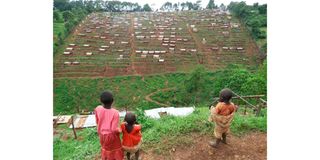Avoid projects which result in maladaptation

Children facing some of the makeshift structures at Tendwet in Narok South where Mau evictees are camping in this picture taken on March 4, 2020.
What you need to know:
- Maladaptation occurs when adaptation projects or actions lead to increased greenhouse gas emissions.
- Counties should explore the six regional economic blocs formed to steer economic growth in the regions.
The Sixth Assessment report of the Intergovernmental Panel on Climate Change (IPCC), “Climate Change 2022: Impacts, Adaptation and Vulnerability”, released this month, has identified three major consequences of global warming for Kenya in the next three decades.
It warns that the number of hungry people could increase by two-folds every year due to the effects of climate change by 2050. It also predicts that cases of water-borne disease will increase and overburden stretched health systems in East Africa.
The third — and most worrying — threat is maladaptation. That occurs when adaptation projects or actions lead to increased greenhouse gas emissions, vulnerability or suffering of people, especially the poor and other vulnerable groups — the adverse side-effects of adaptation actions or projects.
Most often, maladaptation is an unintended consequence; it is still possible even when an adaption project has some positive benefits. Maladaptive actions are unavoidable when the government takes rushed actions to counter impacts of climate change such as drought or floods without proper planning, probably for political expediency.
The government evictions from Mau Forest Complex in 2019 is an example. Some of the families are still in camps three years later, reports say. While the government’s intention was to save the Mau ecosystem — which is threatened by encroachment, heavy deforestation and illegal settlements — rights groups viewed the evictions as inhumane.
Key adaptation behaviour
Climate experts have poked holes in the Lamu Port-South Sudan-Ethiopia Transport (Lapsset) Corridor project which the government believes will help it to achieve Kenya Vision 2030 development goals. They say it can cause relocation of populations and impede access to certain locations for residents. Mobility is a key adaptation behaviour.
Corruption generates maladaptation-increasing risk — for example, where infrastructure is constructed with faulty design, substandard materials and inadequate maintenance. Because several functions, including agriculture, are devolved, there is a high likelihood of adaptation actions undertaken by one county to negatively affect another.
Counties should explore the six regional economic blocs formed to steer economic growth in the regions to plan adaptation projects and actions. Embracing inclusive planning initiatives informed by cultural values and indigenous, local and scientific knowledge is key in minimising maladaptation.
The government must ensure that adaptation projects benefit the locals. As Kenya plans to spend Sh6.2 trillion in execution of policies and programmes in a bid to reduce its greenhouse emissions and impact of climate change in 10 years, it must plan properly to avoid wastefulnes by investing in maladaptation-prone projects and actions.
Mr Onyango, a reporter with ‘Taifa Leo’ and ‘Daily Nation’, is a climate change adaptation master’s student at the University of Nairobi. [email protected]





